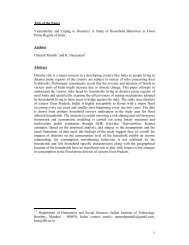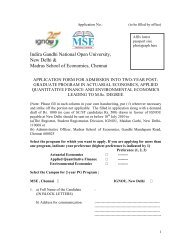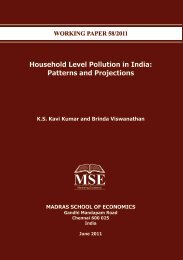A Macro-Fiscal Modeling Framework for Forecasting and Policy ...
A Macro-Fiscal Modeling Framework for Forecasting and Policy ...
A Macro-Fiscal Modeling Framework for Forecasting and Policy ...
You also want an ePaper? Increase the reach of your titles
YUMPU automatically turns print PDFs into web optimized ePapers that Google loves.
Equations are estimated after testing <strong>for</strong> stationarity <strong>and</strong> structural breaks with<br />
or without trend taking into account the current debate concerning trend-stationarity<br />
versus difference-stationarity. The model is validated <strong>for</strong> the sample period. In general,<br />
the sample period will covers the period from 1951-52 to 2006-07, subject to data<br />
constraints.<br />
This model is developed in a manner such that it is suitable <strong>for</strong> <strong>for</strong>ecasting as<br />
well policy simulations. It also provides an analytical framework <strong>for</strong> studying issues of<br />
sustainability of government debt <strong>and</strong> deficit. The model is also suitable <strong>for</strong> application of<br />
norms or prescriptive parameter changes in determining centre‟s <strong>and</strong> states‟ (taken<br />
collectively) tax revenues according to major categories of expenditures of the centre <strong>and</strong><br />
states on the revenue account. It also provides estimates <strong>for</strong> the gross budgetary support<br />
<strong>for</strong> the plan under alternative assumptions.<br />
The outline of chapters is briefly described below. In this Chapter, apart from<br />
these introductory observations on the usefulness of a macro-model <strong>for</strong> the Finance<br />
Commission, an overview of salient trends in important macro variables is also<br />
undertaken.<br />
Chapter 2 provides a discussion on the nature of structural breaks in the Indian<br />
economy <strong>and</strong> examines in this light the stationarity of these macro variables. It is<br />
concluded that all variables of relevance are trend-stationary with structural breaks. In<br />
each case the relevant break dates are identified.<br />
Chapter 3 provides a discussion of the general specification of the model<br />
including stochastic equations <strong>and</strong> identities. There is detailed fiscal sector within the<br />
core model. In addition, there is fiscal sub-model to cater to further dis-aggregation,<br />
where feedbacks with the core model are not significant. The revenue has equations <strong>for</strong><br />
major central <strong>and</strong> state taxes, non-tax revenues, <strong>and</strong> fiscal transfers <strong>and</strong> other<br />
intergovernmental flows so that revenues <strong>and</strong> expenditures on the combined account of<br />
the central <strong>and</strong> the state governments can be derived. Expenditures are divided into<br />
revenue <strong>and</strong> capital expenditures. Revenue expenditures are further divided into interest<br />
payments <strong>and</strong> primary expenditures. Similarly, equations <strong>for</strong> fiscal deficit at the centre<br />
<strong>and</strong> the state levels <strong>and</strong> their accumulation into debt are developed.<br />
The real sector is divided into agriculture, industry, <strong>and</strong> services sectors on the<br />
supply side. On the dem<strong>and</strong> side, components of private expenditures (consumption <strong>and</strong><br />
10



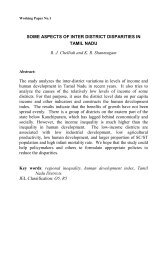
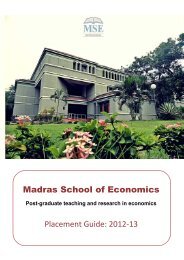
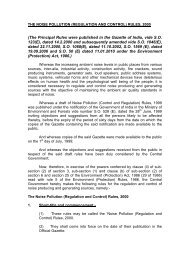
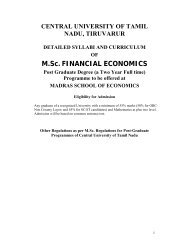
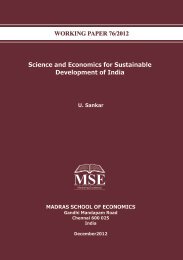
![Curriculum Vitae [pdf] - Madras School of Economics](https://img.yumpu.com/49878970/1/190x245/curriculum-vitae-pdf-madras-school-of-economics.jpg?quality=85)
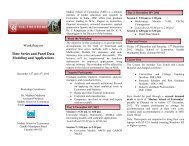
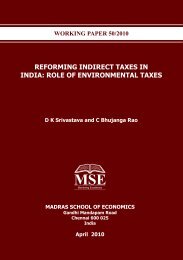
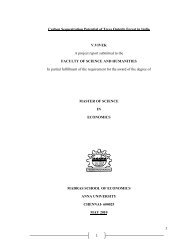
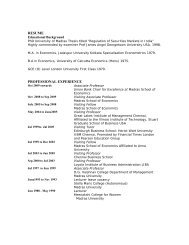
![Curriculum Vitae [pdf] - Madras School of Economics](https://img.yumpu.com/48715201/1/184x260/curriculum-vitae-pdf-madras-school-of-economics.jpg?quality=85)
